Zhaoyang Qu
Extraction of Typical Operating Scenarios of New Power System Based on Deep Time Series Aggregation
Aug 23, 2024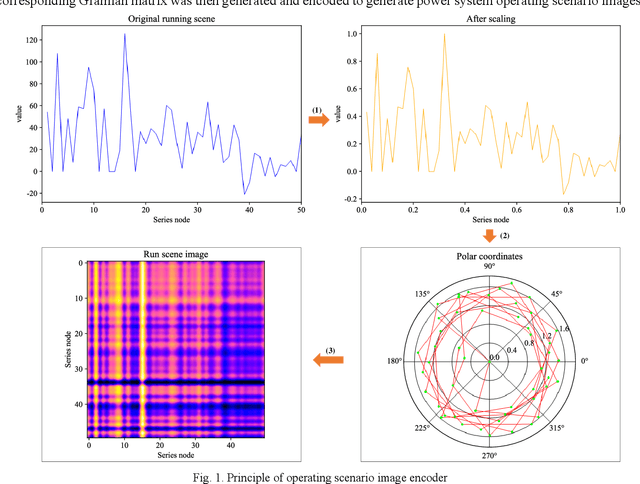
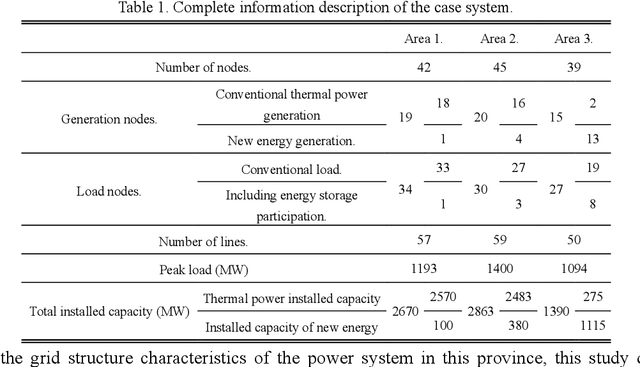
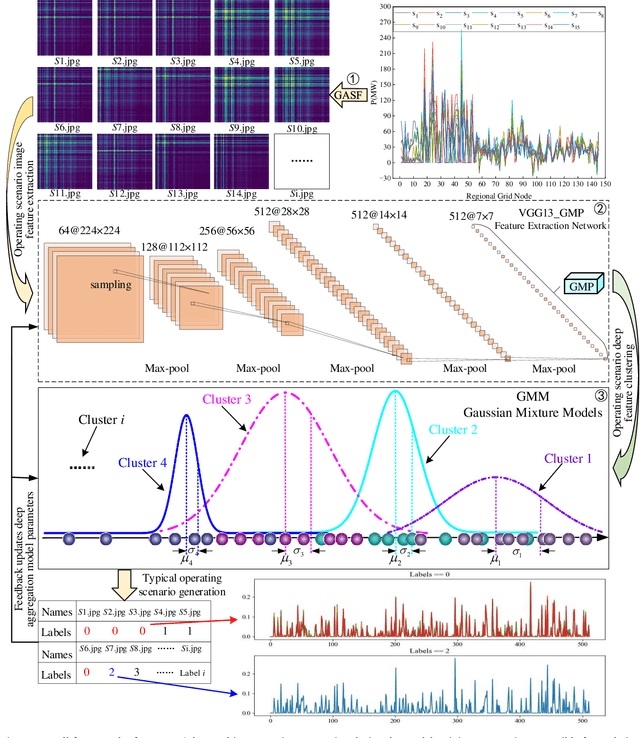
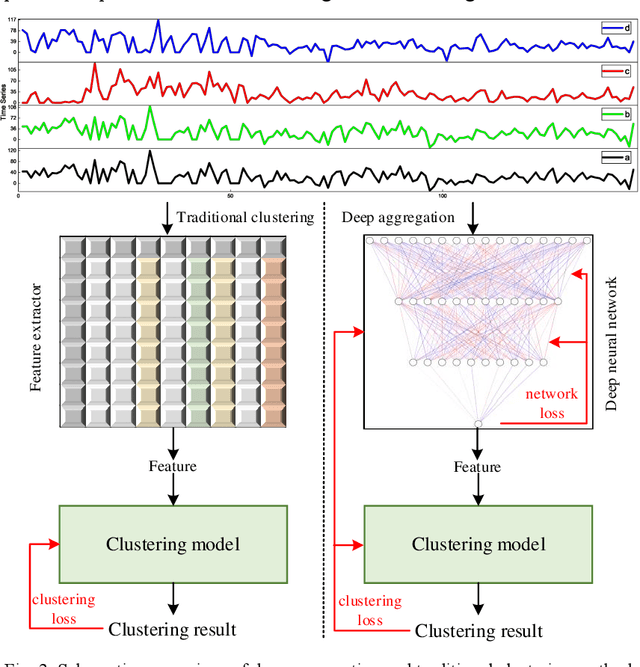
Abstract:Extracting typical operational scenarios is essential for making flexible decisions in the dispatch of a new power system. This study proposed a novel deep time series aggregation scheme (DTSAs) to generate typical operational scenarios, considering the large amount of historical operational snapshot data. Specifically, DTSAs analyze the intrinsic mechanisms of different scheduling operational scenario switching to mathematically represent typical operational scenarios. A gramian angular summation field (GASF) based operational scenario image encoder was designed to convert operational scenario sequences into high-dimensional spaces. This enables DTSAs to fully capture the spatiotemporal characteristics of new power systems using deep feature iterative aggregation models. The encoder also facilitates the generation of typical operational scenarios that conform to historical data distributions while ensuring the integrity of grid operational snapshots. Case studies demonstrate that the proposed method extracted new fine-grained power system dispatch schemes and outperformed the latest high-dimensional featurescreening methods. In addition, experiments with different new energy access ratios were conducted to verify the robustness of the proposed method. DTSAs enables dispatchers to master the operation experience of the power system in advance, and actively respond to the dynamic changes of the operation scenarios under the high access rate of new energy.
Localization of Dummy Data Injection Attacks in Power Systems Considering Incomplete Topological Information: A Spatio-Temporal Graph Wavelet Convolutional Neural Network Approach
Jan 27, 2024Abstract:The emergence of novel the dummy data injection attack (DDIA) poses a severe threat to the secure and stable operation of power systems. These attacks are particularly perilous due to the minimal Euclidean spatial separation between the injected malicious data and legitimate data, rendering their precise detection challenging using conventional distance-based methods. Furthermore, existing research predominantly focuses on various machine learning techniques, often analyzing the temporal data sequences post-attack or relying solely on Euclidean spatial characteristics. Unfortunately, this approach tends to overlook the inherent topological correlations within the non-Euclidean spatial attributes of power grid data, consequently leading to diminished accuracy in attack localization. To address this issue, this study takes a comprehensive approach. Initially, it examines the underlying principles of these new DDIAs on power systems. Here, an intricate mathematical model of the DDIA is designed, accounting for incomplete topological knowledge and alternating current (AC) state estimation from an attacker's perspective. Subsequently, by integrating a priori knowledge of grid topology and considering the temporal correlations within measurement data and the topology-dependent attributes of the power grid, this study introduces temporal and spatial attention matrices. These matrices adaptively capture the spatio-temporal correlations within the attacks. Leveraging gated stacked causal convolution and graph wavelet sparse convolution, the study jointly extracts spatio-temporal DDIA features. Finally, the research proposes a DDIA localization method based on spatio-temporal graph neural networks. The accuracy and effectiveness of the DDIA model are rigorously demonstrated through comprehensive analytical cases.
Active and Passive Hybrid Detection Method for Power CPS False Data Injection Attacks with Improved AKF and GRU-CNN
Feb 14, 2022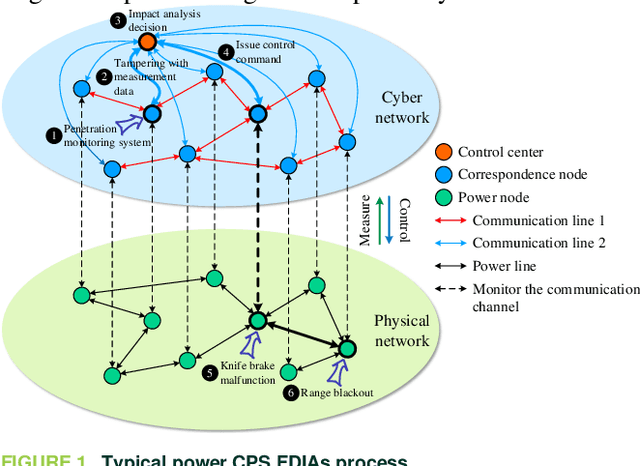
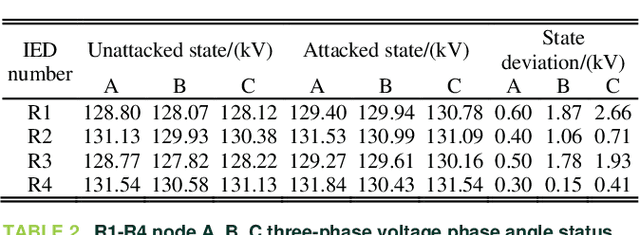
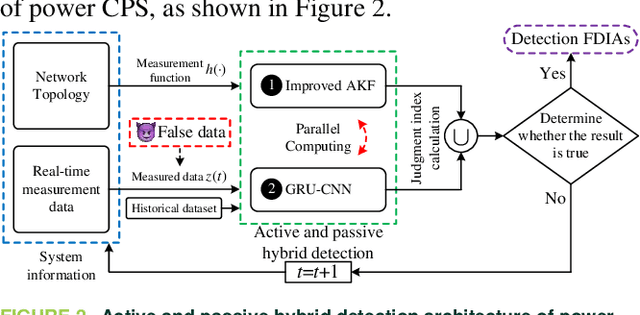

Abstract:Influenced by deep penetration of the new generation of information technology, power systems have gradually evolved into highly coupled cyber-physical systems (CPS). Among many possible power CPS network attacks, a false data injection attacks (FDIAs) is the most serious. Taking account of the fact that the existing knowledge-driven detection process for FDIAs has been in a passive detection state for a long time and ignores the advantages of data-driven active capture of features, an active and passive hybrid detection method for power CPS FDIAs with improved adaptive Kalman filter (AKF) and convolutional neural networks (CNN) is proposed in this paper. First, we analyze the shortcomings of the traditional AKF algorithm in terms of filtering divergence and calculation speed. The state estimation algorithm based on non-negative positive-definite adaptive Kalman filter (NDAKF) is improved, and a passive detection method of FDIAs is constructed, with similarity Euclidean distance detection and residual detection at its core. Then, combined with the advantages of gate recurrent unit (GRU) and CNN in terms of temporal memory and feature-expression ability, an active detection method of FDIAs based on a GRU-CNN hybrid neural network is proposed. Finally, the results of joint knowledge-driven and data-driven parallel detection are used to define a mixed fixed-calculation formula, and an active and passive hybrid detection method of FDIAs is established, considering the characteristic constraints of the parallel mode. A simulation system example of power CPS FDIAs verifies the effectiveness and accuracy of the method proposed in this paper.
Coordinated Cyber-Attack Detection Model of Cyber-Physical Power System Based on the Operating State Data Link
Feb 27, 2021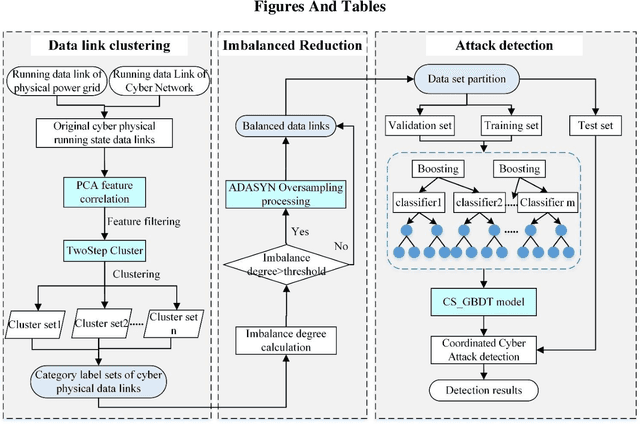
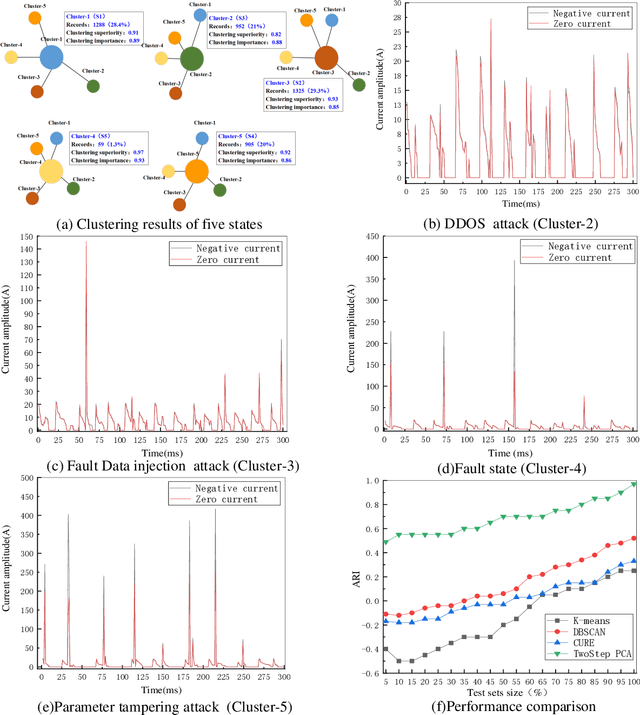
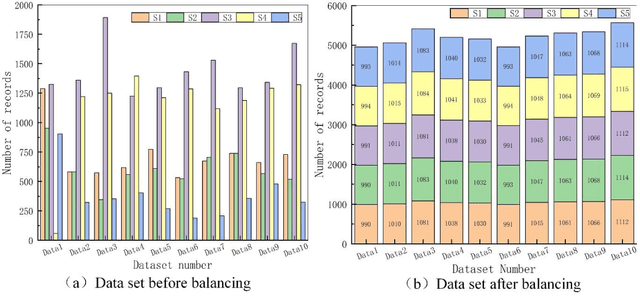
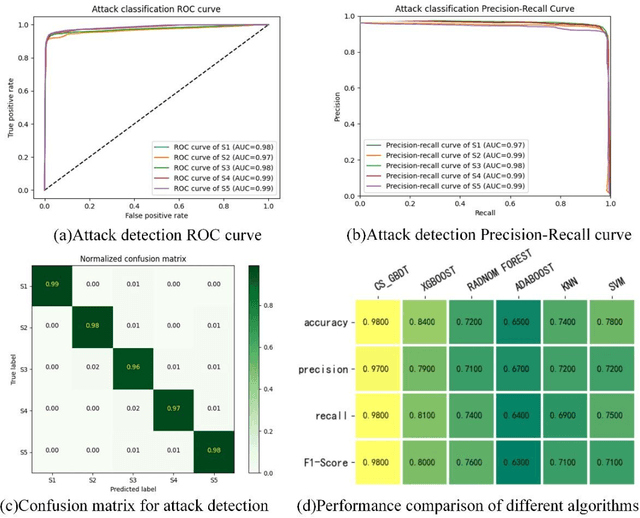
Abstract:Existing coordinated cyber-attack detection methods have low detection accuracy and efficiency and poor generalization ability due to difficulties dealing with unbalanced attack data samples, high data dimensionality, and noisy data sets. This paper proposes a model for cyber and physical data fusion using a data link for detecting attacks on a Cyber-Physical Power System (CPPS). Two-step principal component analysis (PCA) is used for classifying the system's operating status. An adaptive synthetic sampling algorithm is used to reduce the imbalance in the categories' samples. The loss function is improved according to the feature intensity difference of the attack event, and an integrated classifier is established using a classification algorithm based on the cost-sensitive gradient boosting decision tree (CS-GBDT). The simulation results show that the proposed method provides higher accuracy, recall, and F-Score than comparable algorithms.
Modeling Method for the Coupling Relations of Microgrid Cyber-Physical Systems Driven by Hybrid Spatiotemporal Events
Feb 01, 2021
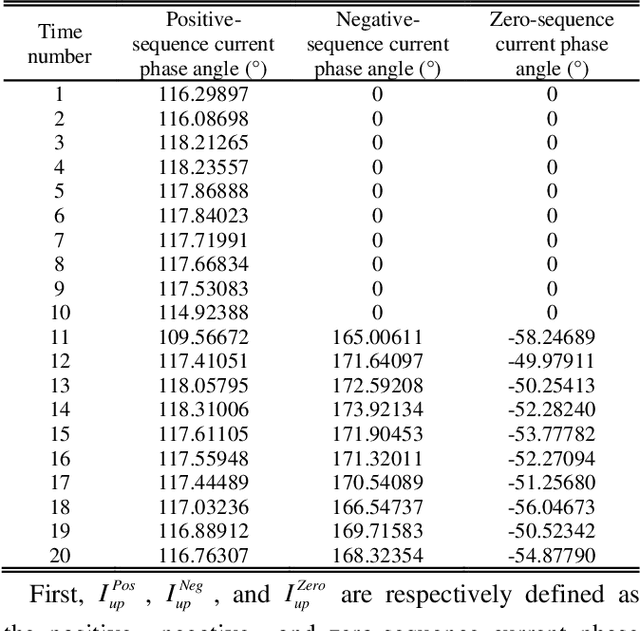

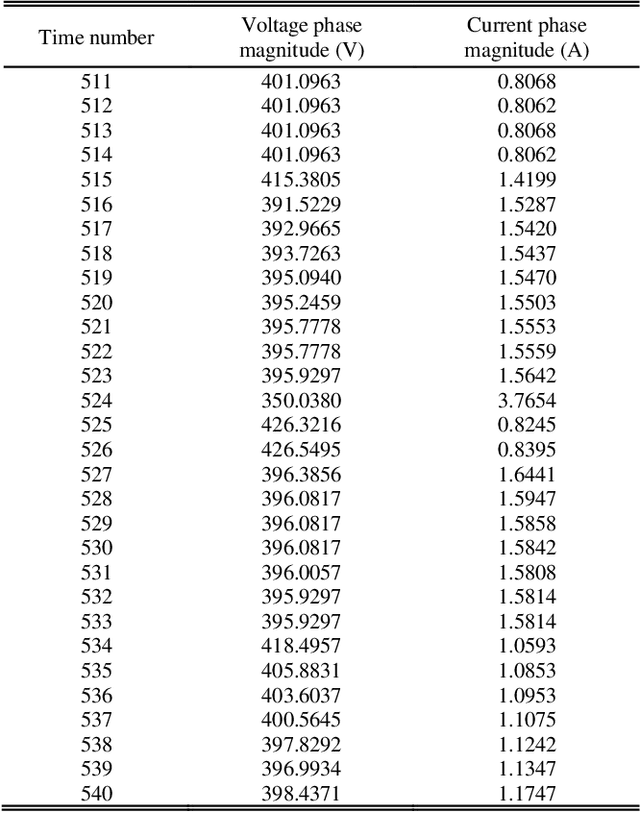
Abstract:The essence of the microgrid cyber-physical system (CPS) lies in the cyclical conversion of information flow and energy flow. Most of the existing coupling models are modeled with static networks and interface structures, in which the closed-loop data flow characteristic is not fully considered. It is difficult for these models to accurately describe spatiotemporal deduction processes, such as microgrid CPS attack identification, risk propagation, safety assessment, defense control, and cascading failure. To address this problem, a modeling method for the coupling relations of microgrid CPS driven by hybrid spatiotemporal events is proposed in the present work. First, according to the topological correlation and coupling logic of the microgrid CPS, the cyclical conversion mechanism of information flow and energy flow is analyzed, and a microgrid CPS architecture with multi-agents as the core is constructed. Next, the spatiotemporal evolution characteristic of the CPS is described by hybrid automata, and the task coordination mechanism of the multi-agent CPS terminal is designed. On this basis, a discrete-continuous correlation and terminal structure characteristic representation method of the CPS based on heterogeneous multi-groups are then proposed. Finally, four spatiotemporal events, namely state perception, network communication, intelligent decision-making, and action control, are defined. Considering the constraints of the temporal conversion of information flow and energy flow, a microgrid CPS coupling model is established, the effectiveness of which is verified by simulating false data injection attack (FDIA) scenarios.
 Add to Chrome
Add to Chrome Add to Firefox
Add to Firefox Add to Edge
Add to Edge